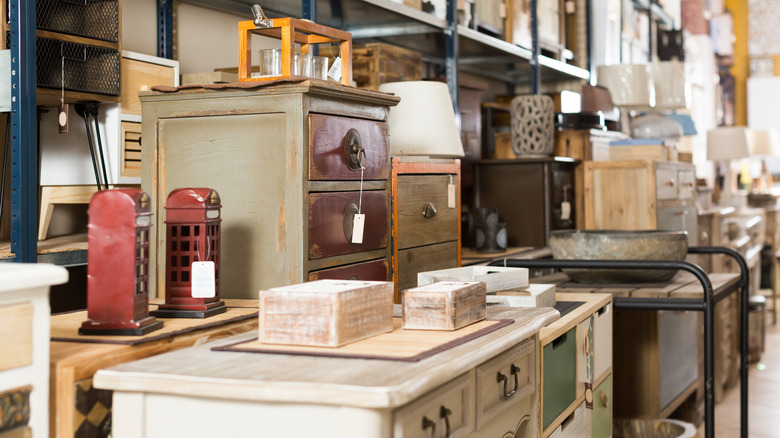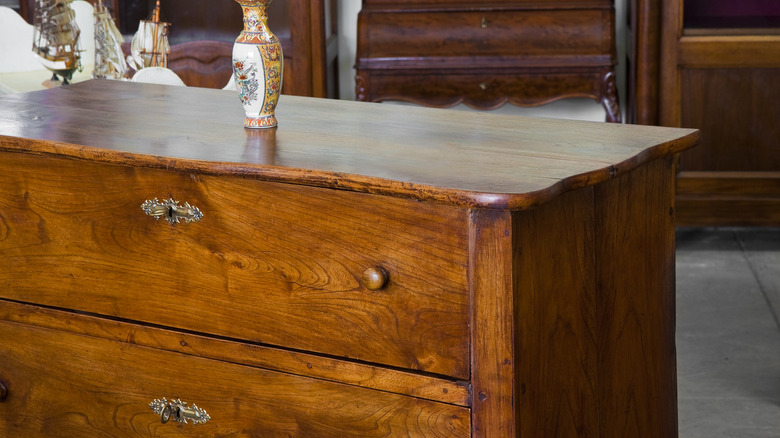The Obvious Sign Antique Furniture May Not Be Authentic
Antiques are a beautiful way to fill your home with a sense of history and style. While the thrill of the hunt is sometimes the point, identifying whether or not your antique is the real thing, by definition at least 100 years or older, can be challenging. While many beautiful and well-crafted reproductions exist, including high-end/high-quality pieces, they can sometimes be difficult to identify from the antique originals on which they're based, leading to confusion among both buyers and dealers. With more and more popular design aesthetics favoring historical-looking pieces, making sure your antique is actually a century old gets trickier, especially as the machine-made pieces of the late 19th and early 20th century become part of the collector's market.
While labels, dates, and manufacturer stamps are a great thing to look for, usually found on the underside, inside drawers, and the back of pieces like headboards or cabinets, are helpful, these marks and stamps can sometimes be absent, unreadable, or possibly faked by unscrupulous sellers. So how can you ensure your antique is as old as you believe it is? There are some very specific details in construction and materials to look out for that identify authentic antiques from fakes.
Look at the joints
One of the surest and easiest ways to determine the authenticity of your antique piece is to inspect the joints and where various elements come together. Dovetailing, which is how the joints of a table or the inside of drawers fit together, can tell you a lot about the age of the piece. Dovetail joins will form patterns like the above, with older, handmade pieces being irregular in both the size and shape of the overlapping wood and how they fit together. These irregularities indicate that the piece was likely constructed prior to the industrialization of furniture making in the late 19th century. Antique pieces, because they were handmade by artisans, would be subject to variations in shape and size that machines eventually eliminated. Look for these variations, as well as methods of earlier construction mortise and tenon joints that involve slots and wooden pegs or tabs that fit securely together.
A lack of variety in the wood used may also indicate that a piece is not an authentic antique. Before the 20th century, most furniture was not constructed with the same wood cuts throughout. Less expensive or attractive pieces of wood were reserved for parts that were not visible. So a dresser exterior may be made of finer woods like teak and rosewood, but the drawers themselves could be made of thinner, inferior wood. The underside of a chair would not be as fine or expensive as the legs and back.
Other little details
In addition to the joints, hardware and fasteners are a great place to look to get an idea of the age of a piece. While the age of metal pieces may be harder to identify than wood, the patina, the wear on a material as it is used and touched, may give a heads up. In addition, since these elements would have been hand molded rather than machine-made, slight variation is possible. Phillips head screws, for example, would indicate 20th-century practices versus rosehead nails, which were popular in previous centuries.
Patina also affects the wood, especially in highly used and handled pieces. While many new pieces have been patinaed and painted to look older or rustic, you can sometimes identify them by the uniformity of their supposed wear. In addition, shrinkage and loose joints may also be a way to identify older pieces since wood that is over a hundred years ago can begin to pull apart as the wood changes size. For upholstered pieces, look for non-synthetic filling materials and fabrics. Antique chairs and sofas will usually include horse hair, feathers, and straw as filler rather than the cotton batting favored later. Manufacturers can often cross-reference the styles of various fabrics, so if something seems more contemporary in its pattern or consistent with recent trends, it may be a reproduction or possibly a genuine but re-upholstered older piece.


